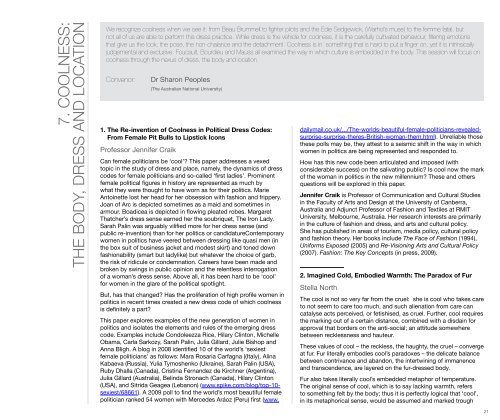2009 AAANZ Conference Abstracts - The Art Association of Australia ...
2009 AAANZ Conference Abstracts - The Art Association of Australia ...
2009 AAANZ Conference Abstracts - The Art Association of Australia ...
Create successful ePaper yourself
Turn your PDF publications into a flip-book with our unique Google optimized e-Paper software.
7. COOLNESS:<br />
THE BODY, DRESS AND LOCATION<br />
We recognize coolness when we see it: from Beau Brummell to fighter pilots and the Edie Sedgewick, (Warhol’s muse) to the femme fatal, but<br />
not all <strong>of</strong> us are able to perform this dress practice. While dress is the vehicle for coolness, it is the carefully cultivated behaviour, filtering emotions<br />
that give us the look, the pose, the non-chalance and the detachment. Coolness is in: something that is hard to put a finger on, yet it is intrinsically<br />
judgemental and exclusive. Foucault, Bourdieu and Mauss all examined the way in which culture is embedded in the body. This session will focus on<br />
coolness through the nexus <strong>of</strong> dress, the body and location.<br />
Convenor:<br />
1. <strong>The</strong> Re-invention <strong>of</strong> Coolness in Political Dress Codes:<br />
From Female Pit Bulls to Lipstick Icons<br />
Pr<strong>of</strong>essor Jennifer Craik<br />
Dr Sharon Peoples<br />
(<strong>The</strong> <strong>Australia</strong>n National University)<br />
Can female politicians be ‘cool’ This paper addresses a vexed<br />
topic in the study <strong>of</strong> dress and place, namely, the dynamics <strong>of</strong> dress<br />
codes for female politicians and so-called ‘first ladies’. Prominent<br />
female political figures in history are represented as much by<br />
what they were thought to have worn as for their politics. Marie<br />
Antoinette lost her head for her obsession with fashion and frippery.<br />
Joan <strong>of</strong> Arc is depicted sometimes as a maid and sometimes in<br />
armour. Boadicea is depicted in flowing pleated robes. Margaret<br />
Thatcher’s dress sense earned her the soubriquet, <strong>The</strong> Iron Lady.<br />
Sarah Palin was arguably vilified more for her dress sense (and<br />
public re-invention) than for her politics or candidatureContemporary<br />
women in politics have veered between dressing like quasi men (in<br />
the box suit <strong>of</strong> business jacket and modest skirt) and toned down<br />
fashionability (smart but ladylike) but whatever the choice <strong>of</strong> garb,<br />
the risk <strong>of</strong> ridicule or condemnation. Careers have been made and<br />
broken by swings in public opinion and the relentless interrogation<br />
<strong>of</strong> a woman’s dress sense. Above all, it has been hard to be ‘cool’<br />
for women in the glare <strong>of</strong> the political spotlight.<br />
But, has that changed Has the proliferation <strong>of</strong> high pr<strong>of</strong>ile women in<br />
politics in recent times created a new dress code <strong>of</strong> which coolness<br />
is definitely a part<br />
This paper explores examples <strong>of</strong> the new generation <strong>of</strong> women in<br />
politics and isolates the elements and rules <strong>of</strong> the emerging dress<br />
code. Examples include Condoleezza Rice, Hilary Clinton, Michelle<br />
Obama, Carla Sarkozy, Sarah Palin, Julia Gillard, Julie Bishop and<br />
Anna Bligh. A blog in 2008 identified 10 <strong>of</strong> the world’s ‘sexiest<br />
female politicians’ as follows: Mara Rosaria Carfagna ((Italy), Alina<br />
Kabaeva (Russia), Yulia Tymoshenko (Ukraine), Sarah Palin (USA),<br />
Ruby Dhalla (Canada), Cristina Fernandez de Kirchner (Argentina),<br />
Julia Gillard (<strong>Australia</strong>), Belinda Stronach (Canada), Hilary Clinton<br />
(USA), and Sitrida Geagea (Lebanon) (www.spike.com/blog/top-10-<br />
sexiest/68661). A <strong>2009</strong> poll to find the world’s most beautiful female<br />
politician ranked 54 women with Mercedes Aráoz (Peru) first (www.<br />
dailymail.co.uk/.../<strong>The</strong>-worlds-beautiful-female-politicians-revealedsurprise-surprise-theres-British-woman-them.html).<br />
Unreliable those<br />
these polls may be, they attest to a seismic shift in the way in which<br />
women in politics are being represented and responded to.<br />
How has this new code been articulated and imposed (with<br />
considerable success) on the salivating public Is cool now the mark<br />
<strong>of</strong> the woman in politics in the new millennium <strong>The</strong>se and others<br />
questions will be explored in this paper.<br />
Jennifer Craik is Pr<strong>of</strong>essor <strong>of</strong> Communication and Cultural Studies<br />
in the Faculty <strong>of</strong> <strong>Art</strong>s and Design at the University <strong>of</strong> Canberra,<br />
<strong>Australia</strong> and Adjunct Pr<strong>of</strong>essor <strong>of</strong> Fashion and Textiles at RMIT<br />
University, Melbourne, <strong>Australia</strong>. Her research interests are primarily<br />
in the culture <strong>of</strong> fashion and dress, and arts and cultural policy.<br />
She has published in areas <strong>of</strong> tourism, media policy, cultural policy<br />
and fashion theory. Her books include <strong>The</strong> Face <strong>of</strong> Fashion (1994),<br />
Uniforms Exposed (2005) and Re-Visioning <strong>Art</strong>s and Cultural Policy<br />
(2007). Fashion: <strong>The</strong> Key Concepts (in press, <strong>2009</strong>).<br />
2. Imagined Cold, Embodied Warmth: <strong>The</strong> Paradox <strong>of</strong> Fur<br />
Stella North<br />
<strong>The</strong> cool is not so very far from the cruel: she is cool who takes care<br />
to not seem to care too much, and such alienation from care can<br />
catalyse acts perceived, or fetishised, as cruel. Further, cool requires<br />
the marking out <strong>of</strong> a certain distance, combined with a disdain for<br />
approval that borders on the anti-social; an attitude somewhere<br />
between recklessness and hauteur.<br />
<strong>The</strong>se values <strong>of</strong> cool – the reckless, the haughty, the cruel – converge<br />
at fur. Fur literally embodies cool’s paradoxes – the delicate balance<br />
between contrivance and abandon, the intertwining <strong>of</strong> immanence<br />
and transcendence, are layered on the fur-dressed body.<br />
Fur also takes literally cool’s embedded metaphor <strong>of</strong> temperature.<br />
<strong>The</strong> original sense <strong>of</strong> cool, which is to say lacking warmth, refers<br />
to something felt by the body; thus it is perfectly logical that ‘cool’,<br />
in its metaphorical sense, would be assumed and marked trough<br />
21



